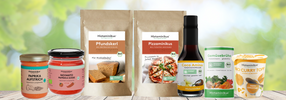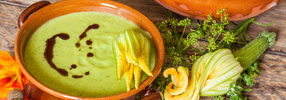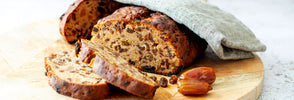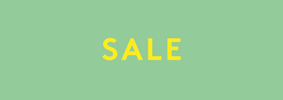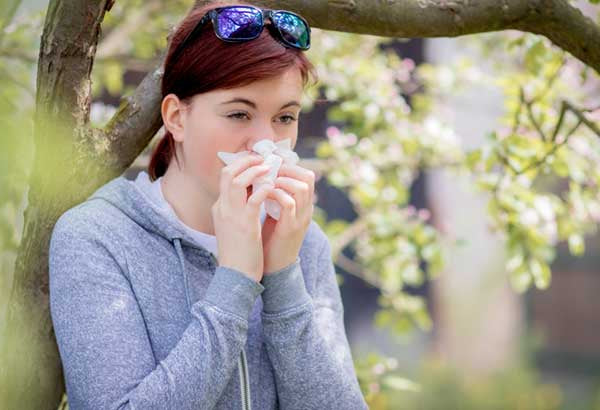
Low -histamine diet in allergies
How allergies and histamine are related
As soon as there are the first warm days in the spring when you could enjoy the sun and long walks, the pollen and Many allergy sufferers suffer from hay fever and from other pollen allergies.
For allergy sufferers, this time is a real gauntlet run and the quality of life is often very limited.
Have you ever wondered why pollen, animal hair and house dust mites make you feel totally uncomfortable that your nose is running and everything itch?
The reason for this is that Subsetting of the messenger substance histamine. Histamine is the guilty behind all the symptoms when they are exposed to an allergen.
Talk about your brand
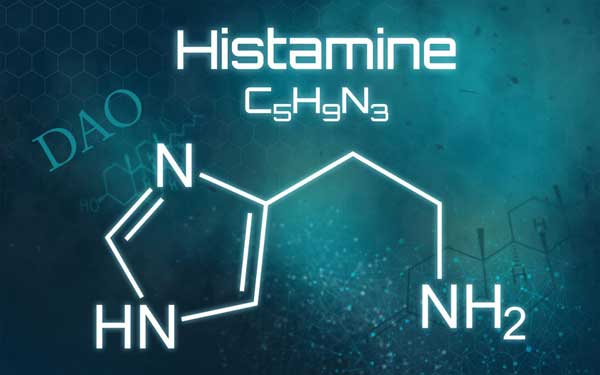
Image with text
What is histamine
Histamine is one Messenger that produces in the mast cells becomes and many Different key functions takes over in our body. Histamine plays one Crucial role in allergies, in the digestive tract and in our neurological system.
For example, it regulates stomach acid production and watches over our sleep and wax rhythm. Actually a very important and vital substance. Histamine is not only produced in our body, but is also contained in many foods. If there is now a surplus of histamine, which cannot be sufficiently dismantled, this vital substance becomes a real problem.
What does histamine have to do with allergies?
An allergic reaction is one Overreaction of the immune system. The immune system sees harmless fabrics such as pollen, animal hair, dust or food as a dangerous fabric that needs to be combated. If the body takes a dangerous substance for it over the gastrointestinal tract, the nose or skin, one becomes one Complex defense reaction set in motion.
From the mast cells (parts of the immune system) excessive amounts of histamine released. The distribution of histamine solves again inflammation And stimulates the Mucus production to. So it comes to them Well-known allergy symptoms: When hay fever, the tissue swells, the nose runs and itches and the eyes red. With these measures, the body tries to get rid of the "dangerous substance". So histamine is the culprit that triggers all types of allergy symptoms.
The logical conclusion for hay fever and pollen allergy sufferers is therefore to avoid or reduce high histamine levels.
And exactly here Your diet comes into play. The last thing you want is to further boost histamine production with the wrong nutrition and to make the symptoms even more.
Many allergy sufferers therefore use a low -histamine diet during spring.
Low -histamine diet in hay fever and pollen allergies
As already mentioned, histamine plays a crucial role in allergic reactions. The increased release of the body's own histamine always ensures the typical allergy symptoms.
If you also absorb too much histamine through the nutrition, there is an even greater excess of histamine, which can worsen the symptoms of an allergy.
So the diet has a major impact on the severity of its symptoms.
Allergy sufferers should therefore be as much as possible during the pollen period eat less -histamine -rich foods, because a low -histamine diet can weaken the symptoms.
A distinction is made between two types of histamine -rich foods:
- Food that even contain histamine as well as
- Food that Release the body's own histamine (So -called histamine liberators).
It makes sense to do without both types of food during the personal pollen allergy period or to minimize them as far as possible.
Histamine intolerance and stress-the stress-histamine cycle
(1.2) Mast cells play a major role in allergic reactions. But this is only a small part of their tasks.
Mast cells Because have a load -bearing Role in identifying and combating pathogens such as bacteria, viruses, parasites and fungi such as Candida Albicans. Mast cells are everywhere in the body, but the largest proportion can be found in our Digestive tract again.
The number of mast cells can increase extremely quickly with intestinal infections. Candida is associated with various intestinal infections such as Crohn's disease, ulcerative colitis, irritable bowel and stomach ulcers. Studies have shown that Candida slowed down the healing process of infections and favors infections in turn. A vicious circle is created.
Candida penetrates the body through mast cell -rich organs (skin, intestine and respiratory tract). Studies by Nosal R. and the Nature Journal (3, 4) confirm that Candida leads to a histamine release in the mast cells. Mast cells have receptors that recognize fungal infections and take appropriate measures to combat, such as the Salvation of histamine. Candida increases in the intestine it comes to Histamine releasethat with inadequate dismantling, Cause inflammation can. Candida also reduces the body's ability to reduce histamine by the Dao reduced. (5)
The next vicious circle is created.
If Candida increases uncontrollably, the fungus also sets toxic metabolic products (mycotoxins) free in our body.
Also generated Candida his own alcohol in our blood.
And we know what reactions alcohol can cause in the case of affected people of histamine intolerance.
Multicolumn
-
Food with a high histamine content
- long -mature cheeses
- Smoked fish, meat and sausage products
- Yeast extract
- Prefabricated baked goods (too many unknown additives contains)
- Finished products and canned products
- Chemical additives
- Refined and preserved foods
- sauerkraut
- Wheat bakery
- fermented food
- Mushrooms, nuts
- Balsamic vinegar, wine vinegar
-
Food that release histamine
- offal
- seafood
- Sunflower seeds
- Tomato
- avocado
- Legumes
- Rukola, spinach
- alcohol
- Bananas, pears, strawberries
- Cocoa and chocolate
- soy
- Mustard
- caffeine
- Citrus
- Glutamate
The list is terrifyingly long, but in the end it means that you eat healthy from natural foods that are not loaded with chemical additives. It is important to eat a balanced diet even during the pollen. A lot of fresh fruit and vegetables as well as grain and meat if necessary should form the basis.
The following foods support a low -histamine diet:
- Fresh meat as natural as possible of poultry, sheep, goat, beef
- Fresh fish or frozen fish
- Fresh milk products: milk, butter, cream, cream cheese (mozzarella, curd cheese, hut cheese, mascarpone, ricotta, fresh cheese), young gouda, butter cheese, layer cheese
- Potatoes, corn, rice, polenta, quinoa, millet
- Cereals: rice, corn, spelled, quinoa, amaranth, oats, millet, teff
- Vegetables (fresh or frozen), e.g. corn, carrots, parsnip, zucchini, peppers, radishes, celery, beetroot, etc.
- Fruits, e.g. apple, peach, apricot, melons, mango, kaki, lychi, cherries, sour cherries, blackberries, blueberries, cranberry, currants, jostabries, coconut, coconut milk, coconut water, macadamia nuts, noble chestnut
- Plant oils (thistle oil, rapeseed oil, olive oil), vegetable fats, animal fats, fish oil
- Salt without iodine, kitchen herbs, mild spices, alcohol vinegar = brandy vinegar = vineyard vinegar, vinegar essence
- Various kitchen herbs fresh or dried
- Sugar, agave syrup, honey, stevia, jams from compatible fruits.
- Water, herbal teas, rooibos nature, juices, fruit nectars and lemonades from compatible ingredients
You can find a more detailed list in our here.
Apart from that, you should have a pollen allergy Drink a lot of natural water.
Also Nutrients and minerals such as magnesium, zinc, selenium and vitamin C are beneficial with a pollen allergy. In particular applies Vitamin C as the histamine gamer. But magnesium also prevents the release of histamine into the bloodstream and can thus weaken the symptoms.
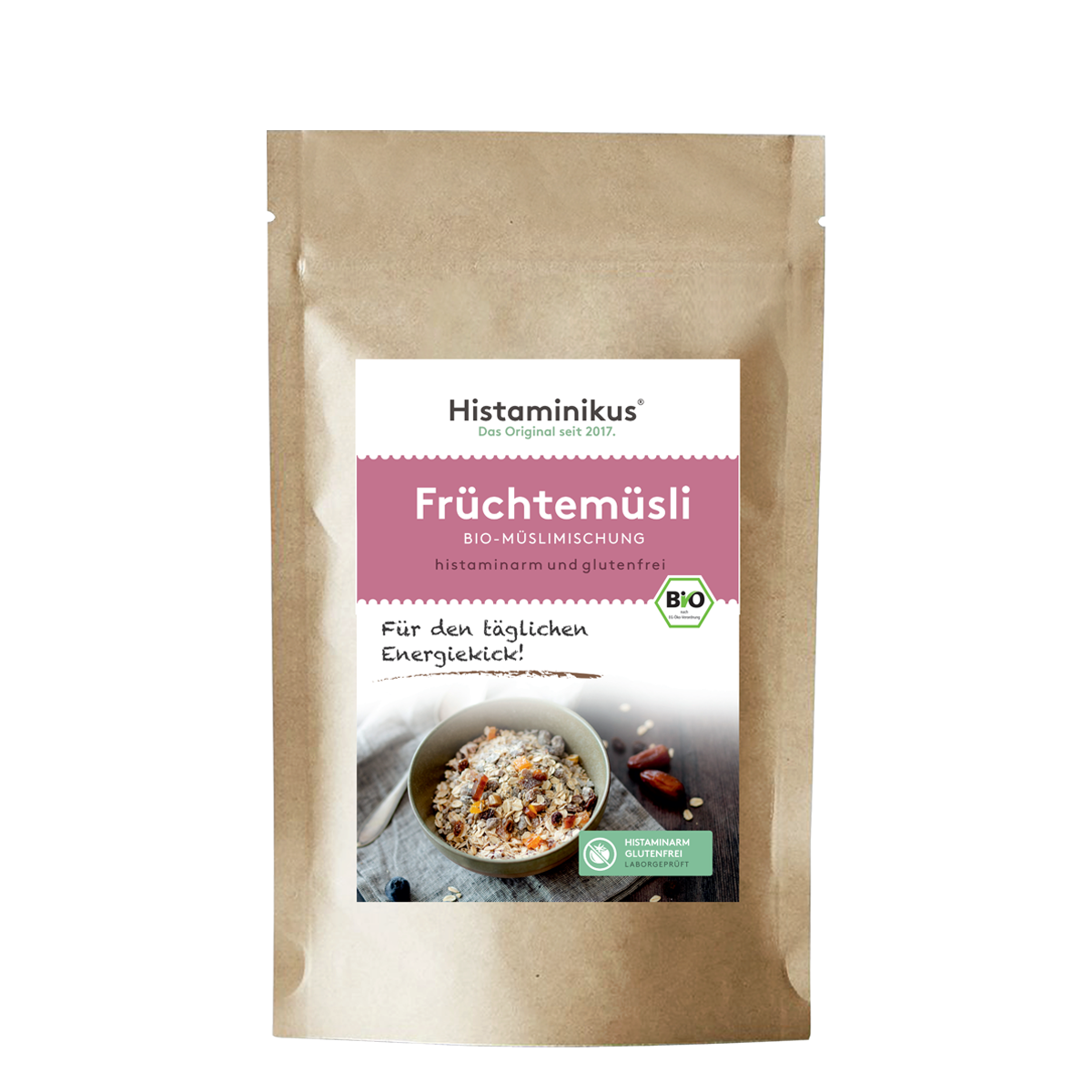
Histamine -free products
Histaminikus
Frukemüsli organic
4.61 / 5.0
(44) 44 total reviews
Share
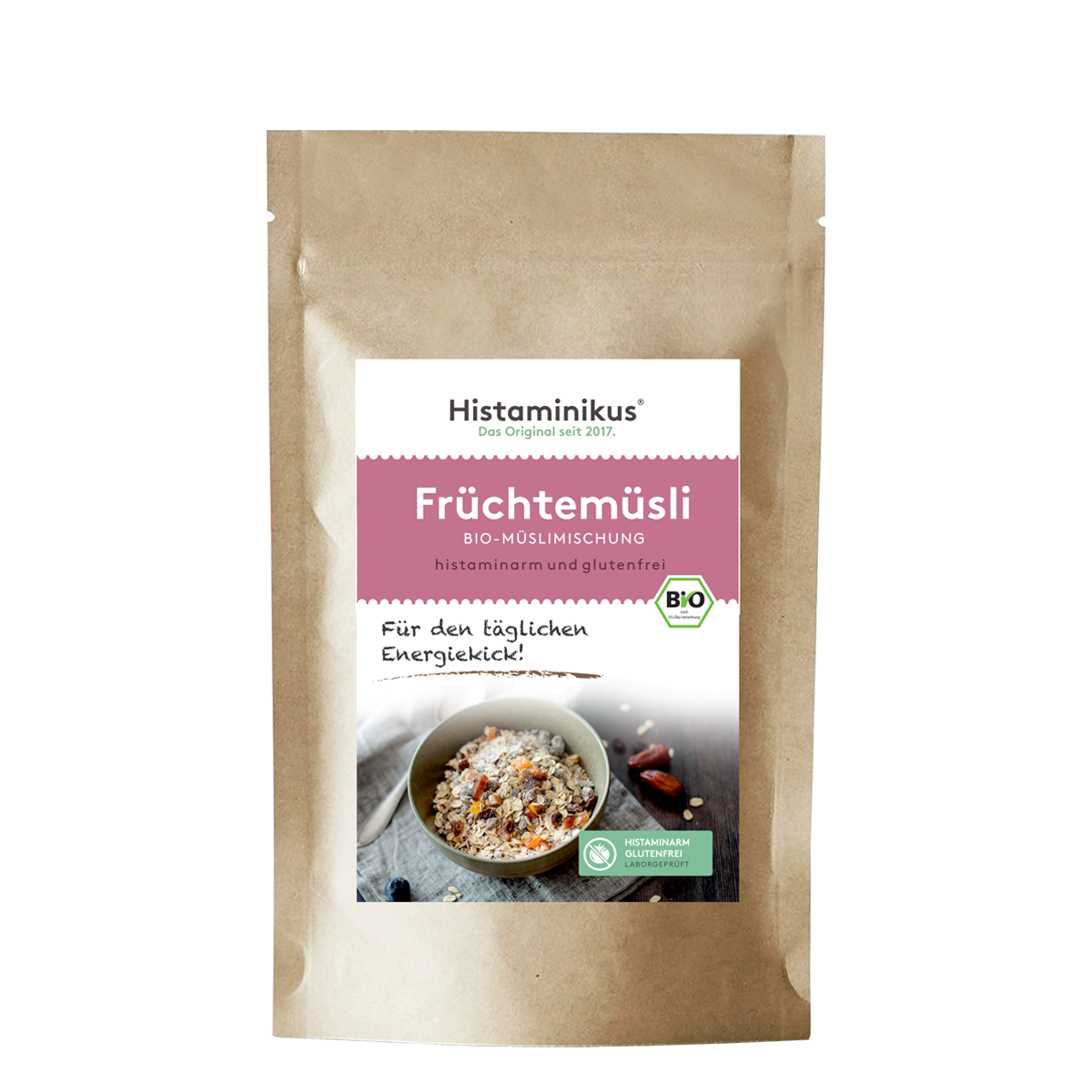
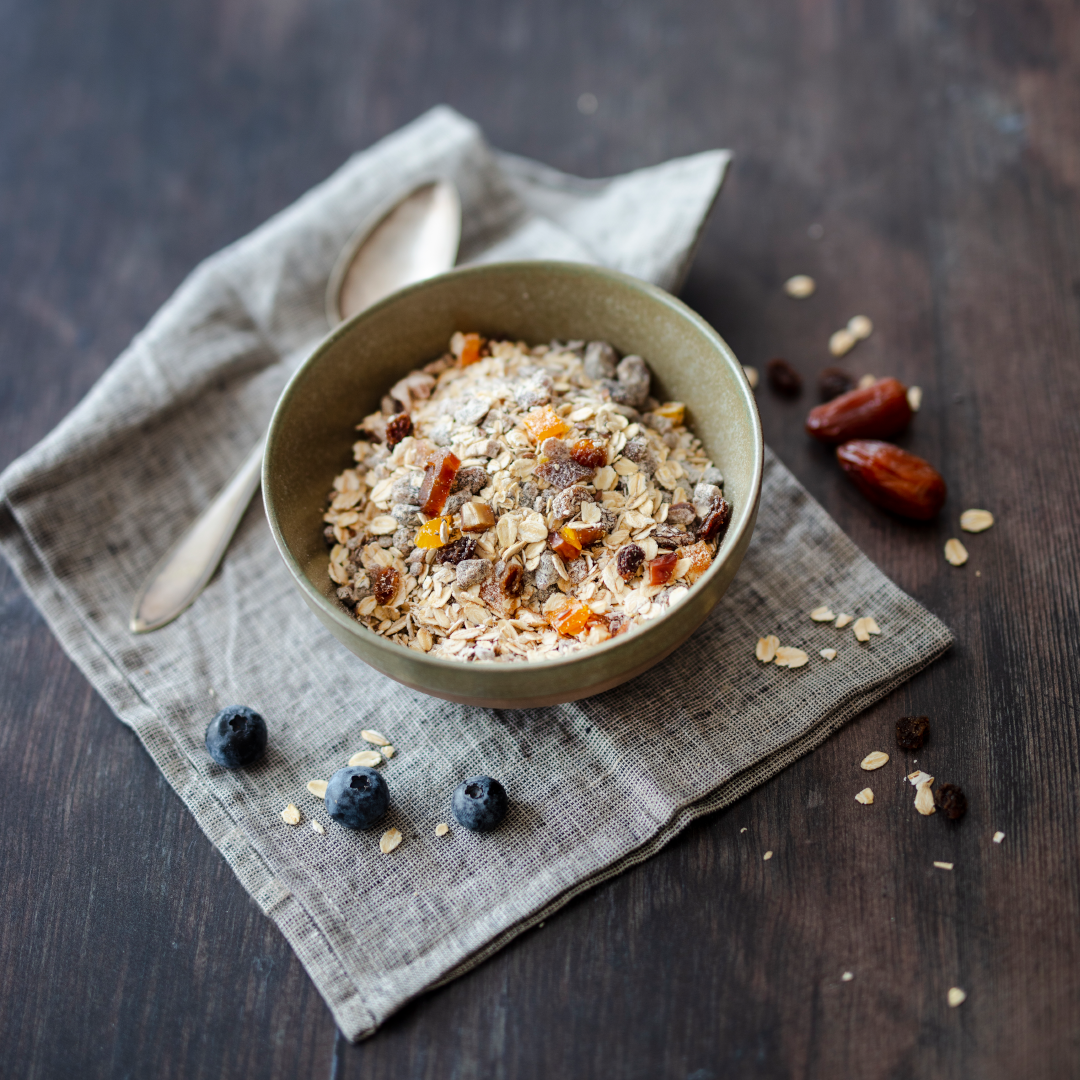
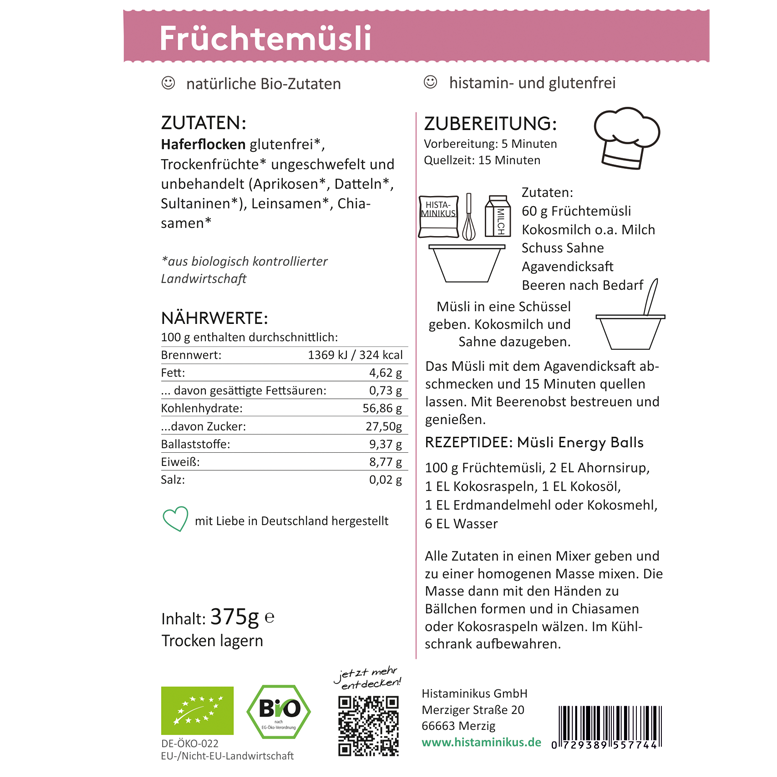
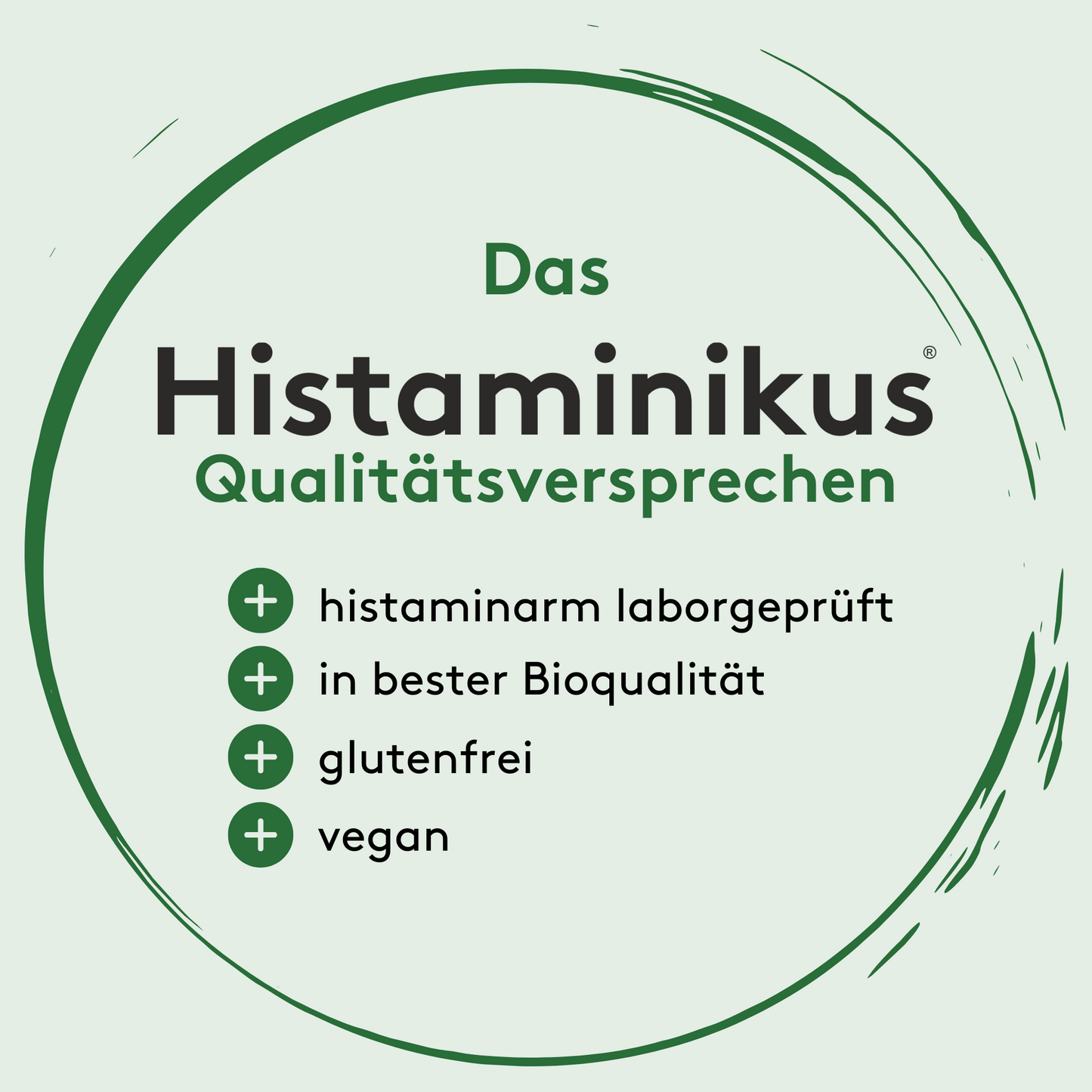
7 points plan for an allergy-poor time
1. Avoid histamine -rich foods
2. Consume bio quality
3. Drink a lot of water or tea
4. Do not use industrially produced foods
5. Avoid additives
6. Reduce dairy products
8. Reduce gluten -containing products
Try to hold out this diet for three months and bring in during this time Nutrition diary. Write your top complaints in the first column.
In the top line, enter the day and evaluate the intensity of the symptoms on a scale from 1 to 10. Experience of naturopaths show that if the diet is strictly complied with, there is a significant improvement in terms of allergens. (1)
After the pollen time, you can slowly start introducing histamine -rich foods into your diet. It is best to start with healthy fruit and vegetables such as tomatoes, avocados, spinach and citrus fruits.
We have to point out that all information on treatment methods, nutrients and vitamins and their effects relate to traditional knowledge, studies and opinions and experiences of therapists and literature. Our contribution cannot replace medical healing treatment with the diagnosis and therapy of a doctor. We cannot give a healing promise either. It is primarily about passing on information. In the event of serious illnesses, non -explanatory symptoms and uncertainty, you should see a doctor. The nutrients or forms of therapy mentioned are used for your own dangers. Everyone has to decide for themselves what and whether they have it!
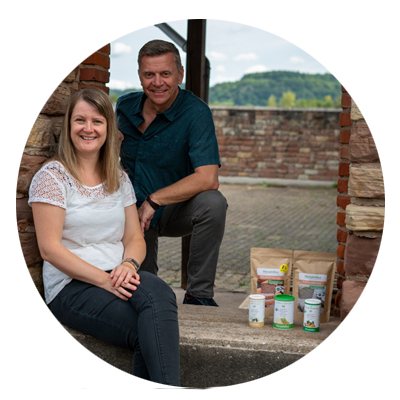
From those affected for those affected
We are Thomas and Michaela Zinser, founder of Histaminikus.
Because of the own histamine intolerance of Michaela and our son, we founded Histaminikus. The frustration does not find any suitable histamine food has spurred us to develop low -histamine food.
We would like to give you back a piece of quality of life. Feel free to look around with us.
Kind regards
Thomas and Michaela

